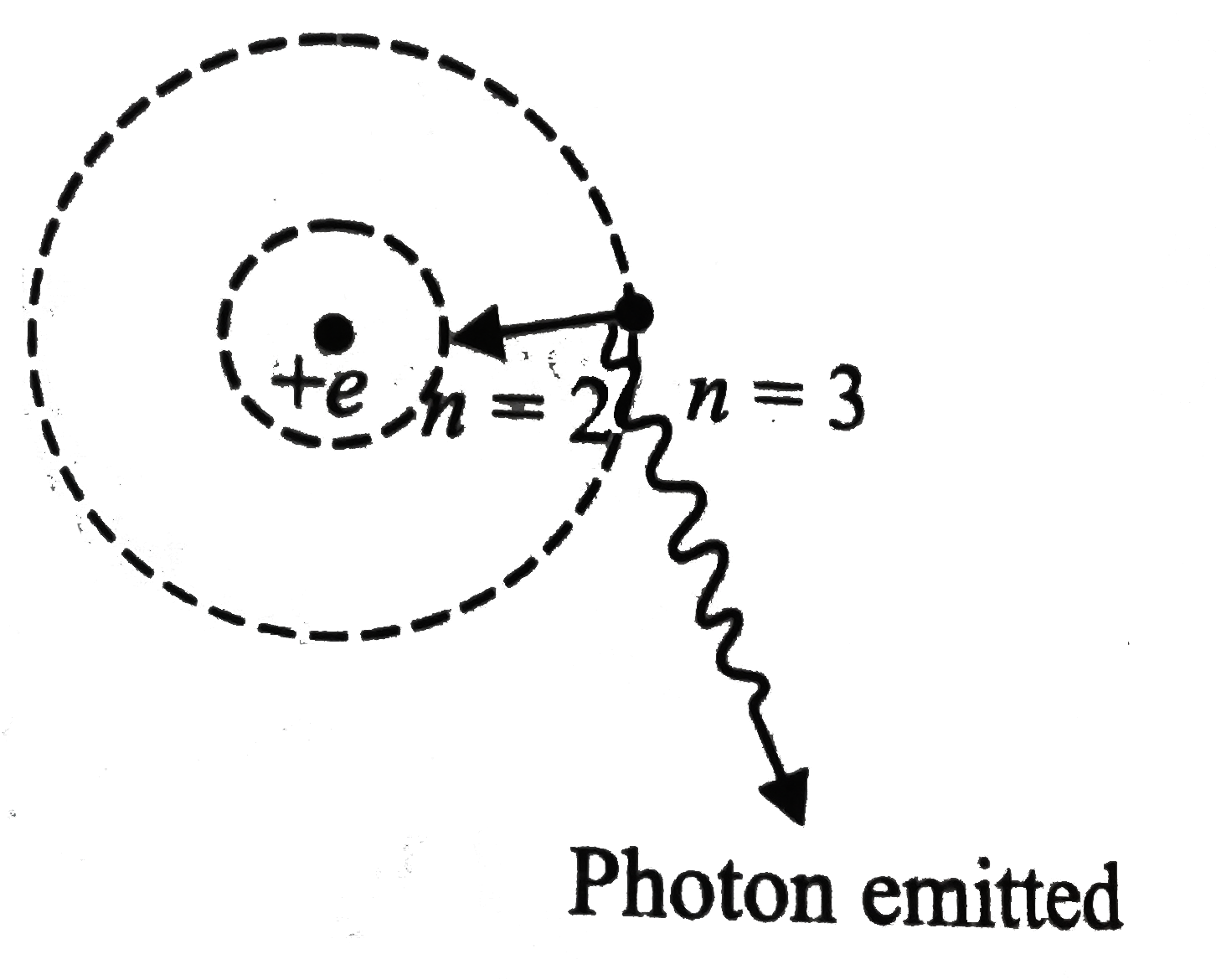A single electron orbits around a stationary nucleus of charge +Ze where Z is a constant and e is the magnitude of electronic charge. It requires 47.2 eV to excite the electron from the second bohr orbit to the third bohr orbit
a. Find the value of Z
b. Find the energy required to excite the electron from n=3 to n=4
c. Find the wavelength of radiation required to remove the electron from the second bohr orbit to infinity
d. Find the kinetic energy, potential energy and angular momentum of the electron in the first orbit
e. Find the ionisation energy of above electron system in electron-volt.
The correct Answer is:A, B, C, D
a.The transition is n1=2→n2=1 by absorbing a photon of energy 47.2eV
⇒ΔE=47.2eV
Using the relation
ΔE=13.6Z2(1n21−1n22)eV
⇒47.2=13.6Z2(122−132)⇒Z=5
b.The required transition is n1=3→n2=4 by absorbing a photon of energy ΔE
Find ΔEby using the relation
ΔE=13.6Z2(1n21−1n22)
⇒ΔE=13.6(5)2(132−142)
⇒ΔE=16.33eV
c.The required transition is n1=2→n2=∞ by absorbing a photon of energy ΔE
Find ΔEby using the relation
ΔE=13.6(5)2(122−1∞2)
⇒ΔE=85eV.Find λ of radiation corresponding to energy 85eV
⇒λ=hcE=6.63×10−34×3×10885(1.6×10−19)
=146.25×10−10=146.25Å
If energy of electron be En then KE=−En and PE=2En
En=−13.6Z2n2=−13.65×5212=−340eV
KE=(−340eV)=340ev
PE=2(−340)=−680eV
e. Ionization energy =ΔE=13.6(5)2(122−1∞2)
∴ΔE=85eV
Topper's Solved these Questions
- ATOMIC STRUCTUREBOOK - CENGAGE CHEMISTRYCHAPTER - ATOMIC STRUCTUREEXERCISE - Concept Applicationexercise(4.3)
19 Videos
- ATOMIC STRUCTUREBOOK - CENGAGE CHEMISTRYCHAPTER - ATOMIC STRUCTUREEXERCISE - Concept Applicationexercise (4.1)
11 Videos
- APPENDIX - INORGANIC VOLUME 1BOOK - CENGAGE CHEMISTRYCHAPTER - APPENDIX - INORGANIC VOLUME 1EXERCISE - chapter-7 Single correct answer
1 Videos
- CHEMICAL BONDING AND MOLECULAR STRUCTUREBOOK - CENGAGE CHEMISTRYCHAPTER - CHEMICAL BONDING AND MOLECULAR STRUCTUREEXERCISE - Archives Subjective
15 Videos
Similar Questions
A single electron orbits around a stationary nucleus of charge +Ze, where Z is a constant and e is the magnitude of the electronic charge. It requires 47.2eV to excite the electron from second Bohr orbit to the third bar Bohr orbit. Find :
(a) the value of Z,
(b) the energy required to excite the electron from n=3 to n=4.
View SolutionA single electron orbits around a stationary nucless of charge +Ze where Z is a constant and e is the magnitude of electronic charge ,if respuires 47.2 e

is excite the electron from the second bohr orbit to the third bohr orbit
a. Find the value of Z
b. Find the energy required to the electron from n=3 ton=4
c. Find the wavelength of radiation to remove the electron from the second bohr orbit to infinity
d. Find the kinetic energy potential energy and angular momentum of the electron in the first orbit
Find the ionination energy of above electron system in electronvalt.
View SolutionA single electron orbits around a stationary nucleus of charge +Ze, where Z is a constant and e is the electronic charge. It requires 47.2eV to excited the electron from the second Bohr orbit to the third Bohr orbit. Find (i) the value of Z, (ii) the energy required to excite the electron from the third to the fourth Bohr orbit and (iii) the wavelength of the electromagnetic radiation radiation to remove the electron from the first Bohr orbit to infinity.
View SolutionA single electron orbikt around a stationary nucleus of charge +Ze when Z is a constant and e is the magnitube of the electronic charge if 47.2eVexcitethee≤ctronomthesecondbohrorbit→thethirdbohhrorbitf∈al<br>(i)ThevolueofZ<br>(ii)Tyhee≠rgyrequiredtoνc≤usthee≤ctronomthethird→thefourthbohrorbit<br>(iii)Thewave≤n>hofthee≤ctronmag≠ticradiationrequired→removethee≤ctronomthefirstbohrorbit→∈l∈ity<br>(iv)Thee≠rgypotentiale≠rgypotentiale≠rgyandtheanga––rmomentumofthee≤ctron∈thefirstbohrorbit<br>(v)Theradiusofthefirstbohrorbit(Theionizatione≠rgyofhydro≥na→m = 13.6 eV bohrradius= 5.3 xx 10^(-11) matrevelocityoflight= 3 xx 10^(8) m//secplanks'sconstant = 6.6 xx 10^(-34) jules - sec )
View SolutionAn electron is placed in an orbit about a nucleus of charge +Ze. It requires 47.2 eV energy to excite an electron from second Bohr orbit to third Bohr orbit. What is the value of Z?
View SolutionA single electron orbits a stationary nucleus of charge +Ze, where Z is a constant and e is the magnitude of electronic charge . It requires 47.2eV to excite . Find
a the value of Z
b the energy required to excite the electron from the third to the fourth Bohr orbit.
the wavelength of electromagnetic rediation required to remove the electron from the first Bohr orbit to infinity.
d Find the KE,PE, and angular momentum of electron in the first Bohr orbit.
the redius of the first Bohr orbit
[The ionization energy of hydrogen atom =13.6eV Bohr radius =5.3×10_11m, "velocity of light" =3×10−8jms−1, Planck's constant =6.6×10−34j−s]
View SolutionA single electron ion has nuclear chrage +Ze where Z is atomic number and e is electronic charge. It requires 16.52eV to excite the electron from the second Bohr orbit to third Bohr orbit. Find
(a) The atomic number of element?
(b) The energy required for transition of electron from first to third orbit?
(c ) Wavelength of photon required to remove electron from first Bohr orbit to infinity?
(d) The kinetic energy of electron on first Bohr orbit?
View SolutionAn energy of 68eV is required to excite a hydrogen like atom from its second Bohr orbit to the third. The nuclear charge is Ze. Find the value of Z, the kinetic energy of the electron in the first Bohr orbit and the wavelength of the radiation required to eject the electrons from the first Bohr orbit to infinity.
View SolutionDetermine the wavelength of the radiation required to excite the electron in Li++ from the first to the third Bohr orbit.
View SolutionAn energy of 68.0 eV is required to excite a hydrogen-like atom in its second Bohr orbit to third. The nuclear charge is Ze. Find the value of Z, the kinetic energy of the electron in the first Bohr orbit and the wavelength of the electronmagnetic radiation required to eject the electron from the first orbit to infinity.
View Solution
